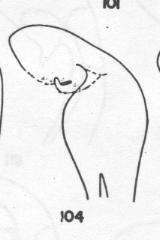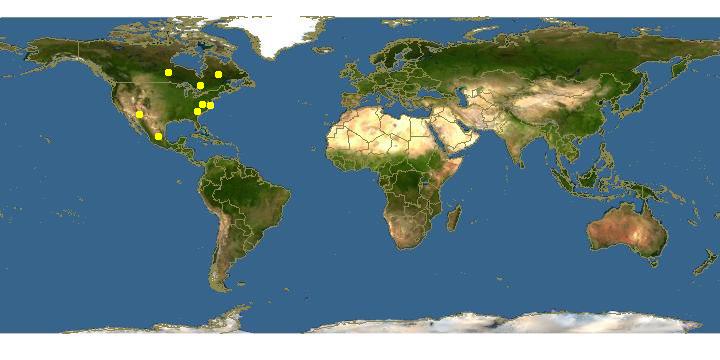
Arnold S. E. Menke, 1965 · 1
Ammophila fernaldi, penis valve head |

Click on map for details about points.
|
|
Overview |
Taken from: A Revision of the North American Ammophila (hymenoptera, Sphecidae). Arnold S. E. Menke, 1965.
Ammophila (Ammophila) fernaldi (Murray)
(Figs. 90, 104)
Sphex fernaldi Murray, 1938. Ann Entomol. Soc. Amer. 31:19. Holotype female, Luverne, Minnesota (University of Minnesota, Saint Paul).
This species most closely resembles placida and pictipennis but the shiny pleura are distinctive. In addition, the genitalia and eighth sternite are diagnostic (figs. 90, 104).
Murray’s type has not been seen, but I have studied paratypic material.
Ammophila fernaldi occurs east of the Rocky Mountains in the United States. In the southern part of the range fernaldi extends as far west as southern Arizona and southward into Mexico.
Ammophila nigricans Group
Diagnosis. Primary characters: Free margin of male clypeus essentially truncate apically, truncation sometimes broadly, shallowly emarginate; hypostoma in male without a process; collar and scutum without ridges; propodeal enclosure usually with broadly spaced ridges, which are uniform across width of enclosure, interspaces granulate, surface dull (figs. 20-21); preëpisternal sulcus usually long, ending in ventral region, (sometimes Indistinct below pronotal lobe or lacking in apicalis, pictipennis, extremitata, placida and nigricans males and both sexes of con); penis valve head usually with a basal spine-like process (except in apicalis, extremitata and pictipennis) base of gonoforceps sot dorsoventrally elongate. Secondary characters metapleural flange not lamellate; forewing with three submarginal cells.
Included North American species. Ammophila extremitata Cresson, fernaldi (Murray), femurrubra Fox, mcclayi Menke, nigricans Dahlbom, pictipennis Walsh; placida Smith, and xanthoptera Cameron. Other New World species in the group are: apicalis Guérin-Mêneville (West Indies), centralis Cameron, cora Cameron and gaumeri Cameron (Mexico and Central America).
Discussion. The granulate appearance of the propodeal enclosure is diagnostic for the group. In addition, the mesosoma in most North American species is largely devoid of appressed silver hair and the integument is mostly dull black or opaque. Most species in the nigricans group have bluish micropubescence on the head and mesosomal dorsum, and in a few species it coven the entire body. Females of six species (apicalis, cora, extremitata. femurrubra, pictipennis and usually have a minute tooth on the inside edge of the claw near the base (fig. 30). The other species sometimes have a poorly defined tooth on the claw.
The male genitalia, especially the aedeagus and gonoforceps, display excellent specific differences in most species of this group. The shape of the subgenital plate is also of importance. The presence or absence of appressed silver hair on the face, pronotal lobe and other mesosomal areas is of considerable value in species discrimination. Wing color is often diagnostic when used with other characters.
The nigricans group is restricted to North and Central America but appears closely allied with the fallax group of the Old World.
|
|
|
Names | |
|
|
| Supported by | |
Updated: 2024-04-26 00:20:05 gmt
|